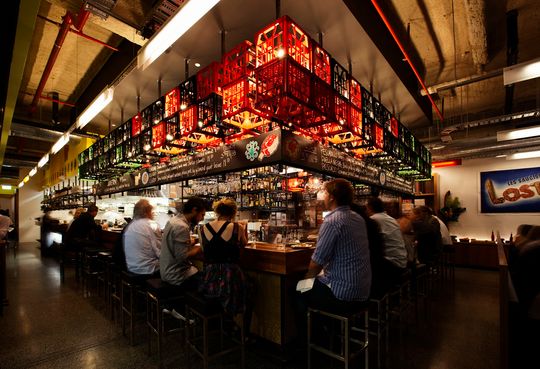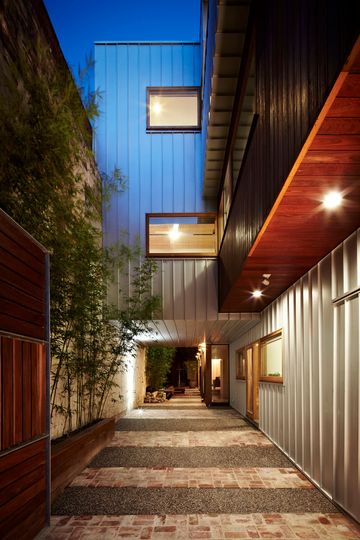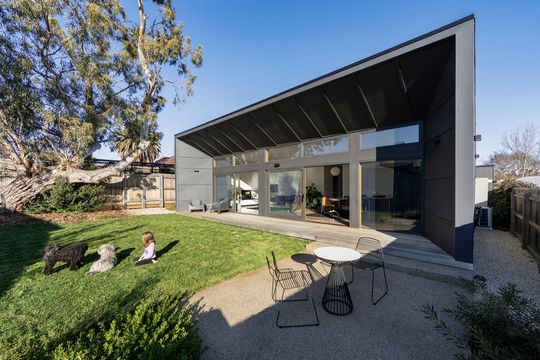When you're a kid buying your first album, you don't expect it will carry such weight years later when you're asked in an interview to name the first album you ever bought. Would you choose differently with the benefit of hindsight? Adam would...
Today, over a virtual spread of MoVida tapas, we're lunching with Adam Dettrick from Adam Dettrick Architects. We've featured several of Adam's homes, most recently Fibro House, a great project in Castlemaine inspired by the classic Australian fibre cement beach shack.
Brodie: What's your favourite lunch choice? Where would we be lunching if this wasn't a virtual luncheon?
Adam: Well, of course, we would be going to MoVida. It's not far from my office. It's one of our fit-outs too, so why not? The one down near the courts, MoVida Aqui.
Is it really? I didn't realise that! Great work.

MoVida Aqui designed by Adam Dettrick Architects. Photo by Trevor Mein
What drew you to architecture, Adam?
When I was in high school, I went on a trip to Canberra. We went to the High Court and the National Gallery of Australia and those two buildings blew my mind. At that moment, I realised that architecture can be quite amazing and can play a really big role in civil society. I think that's what got me over the line.
Do you have a very mild superpower?
Maybe it's being able to look at the detail and the big picture.
Oh yeah, that's a really important skill for an architect. You really have to be across everything at various different levels from the overall concept through to the tiniest of details.
What's your favourite thing about residential architecture?
I think one of my favourite things is actually working with the people that are going to live in the home. In larger projects, your client possibly will never even experience your building or, if they do, it will be in a very limited way. So actually working with the people whose children and families are enriched by the building and get to experience that on a daily basis as part of their lives, that's what I like about residential. With commercial, it's just not the same. That's why we spend so much time talking about things like taps on the residential jobs, because actually, it's an important decision; the client will be using the taps, whereas in commercial, no one cares as much. It's important for the architect as well because, to quote Winston Churchill, 'we shape our buildings and thereafter, they shape us', you want to get the shaping right so [the client is] not shaped in a negative way by their building.
What's the first album that you bought?
I had to really scratch my head for this one. I wish it was INXS, but I'm pretty certain that was the second one. The first one was Kids in the Kitchen.
Maybe this needs a follow-up question, 'what's the first album you wish you bought?'
It wouldn't be Kid in the Kitchen, it would be Pseudo Echo. But yeah, what can I say?
Look, nothing wrong with a good new wave local band...
What's your favourite challenge when it comes to residential architecture?
I think in all architecture, I'm very much socially oriented. So I think one of the things that is missing in a lot of architecture is social intelligence: Getting private versus public right, the relationship between spaces, and also between the house or building and the public realm, getting those things right, making people feel comfortable about where they are and what they're doing.
For example, the full glass, floor-to-ceiling window facing the street to me is like, who's going to want to live there? They're just going to have their blinds down for the whole day. It just doesn't make sense. So, I think it's the social side of things. I'm also keenly interested in the environment. For me, socially positive design comes first, environmentally positive design as well. Obviously, within that, you're dealing with the client's brief and stuff like that, but they're the building blocks necessary to get a good design.
It's about being able to put yourself in the shoes of the people living in the building or those people interacting with the building. A lot of modern architecture is missing that human element. Unfortunately, there's this idea that to be social design, it needs to look like some farm building, but it doesn't. You can still be just as cool and modern, just with the right amount of glass, the right relationship, maybe some openable windows connecting with the street, whatever it is, you can do all that and still look super cool.
Is there a residential project of yours that you're most proud of and why?
I think, looking back, I did this house in North Melbourne. It was a tight space inside an existing warehouse, but it was a new build. So we just had these two really high walls and then the rest was open. We put a three-storey house in there. It came with a design with a town planning permit which was all wrong. So it was really nice to put in something that was all right. And you knew it was all right, because it came with a design that was all wrong. It was very easy to say, well that's definitely what we don't want!
It was really challenging because the site was very tight, we had to go to three stories. We had to design for intergenerational use and ageing in place, so there's a granny flat on the ground floor, two floors of living above and a lift. And also I got to throw in a bit of the Islamic House, because it's kind of like a courtyard house. It's a linear courtyard, more like a laneway, but you walk in off the street into the courtyard, which is a very Islamic thing to access the house from the courtyard. The whole house overlooks the courtyard. I like it when I can throw in pieces of really good quality designs from elsewhere just to make it work. And it really did work. It was a bit of a technical challenge as well as a design challenge.
Wow, sounds like you managed to pack a lot into a very tight space.
Yeah, the site was around 140 square metres and the house was maybe double that. Maybe not quite double, 230 square metres or something like that.

North Melbourne House by Adam Dettrick Architects. Photo by UA Creative
Okay, you're having the ultimate dinner party and you can invite four people from any time period. Who do you invite?
I'd have to invite a couple of architects. Couldn't be all architects, though! I'm thinking Robin Boyd. I thought it was so sad that he was stolen from us so young. He did so much while he was around, he was just finding his form. [Richard] Neutra. Love his stuff. David Attenborough brings in the nature. And Austin Powers because you've got to have some laughs.
Great choices, I'm there!
Okay, so what's your favourite season?
When I think seasons, I think the [indigenous people's] six seasons is so much more appropriate. You've got high spring and early spring and high summer and early summer. If you think in four seasons, it doesn't work in Melbourne. Winter doesn't start until almost spring. Summer doesn't start kicking in until the last month of summer. So out of that, I reckon I like deep winter. I'm a skier, therefore, [in winter] I get my needs satisfied. And true spring. It's the darling buds of May, but in this case, it's the darling buds of September. Spring is a great time and true spring, because the aboriginals have two springs, in true spring it's blustery, it has all this excitement. I'm thinking Vivaldi playing in the background, the Four Seasons. Just enjoying the fact that all the flowers are coming out and it's going to warm up.
Would you prefer to work on new homes or renovations and why?
I don't think I've got a preference there. There's pluses and minuses for both and I sort of sit on the fence. New homes are great, because it's just one design, and you're not having to be held back by the old thing that you have to deal with. So that's good and I do enjoy that. But with a home extension, there's just a bit more to it. It's not just about you and the client, there's someone else, a very important person: the existing house. So the three of those parties need to come together to create something that complements the existing house, meshes in with what the clients want, and be a piece of architecture at the same time. There's a lot involved in extensions. A new home is always a nice thrill, but a house extension takes a bit more effort. Not just in the fact that there's all the drawings required, it's dealing with that third party which makes a more challenging process, but can also make the ultimate design better.

Fibro House by Adam Dettrick Architects. Photo by UA Creative
What's something that you something about architects that you wish more of the general public knew?
We're allowed to wear colours other black. I think we're both wearing black. But mine's a polar fleece because I rode the bike and I haven't changed.
Yes, and I'm wearing Navy Blue, but admittedly it does look black on camera!
Have you heard some life advice that you think would be helpful to other people?
I just finished watching Jumanji with my daughter, so I'm going to quote Jumanji. The kids were in detention and the principal came in and said something along the lines of, you have one life and you get to decide how you live. So make sure you make the right decisions. I thought that was pretty profound.
Who's your favourite architect out of Frank Lloyd Wright and Le Corbusier?
I wouldn't play favourites. There's room in the world for both. How could you say one was better than the other? They're both superstars in their own ways. I love the anecdotes, too.
Definitely personalities, aren't they?
Yep, big on personality. So I'm on the fence there.
What is the best piece of advice that you would give someone who was planning to build or renovate?
Use an architect!
Why do you think it's beneficial for people to work with an architect?
To put it bluntly, you spend a lot of money on your house. It's normally the most money you spend on anything in your life. So putting some time and effort into getting the right advice about where the rooms go, and what it looks like, is actually an investment. So you can spend $600,000 on a house that, when you move in, you think, well we stuffed that up. Or you can spend the same amount, because it doesn't have to change the price of the build, but you spend that money more wisely: so that all the walls are where they need to be and you don't have an extra room that you don't need, the living room is designed for your furniture, as opposed to, 'Oh my God, we can't get our couch in, I'm going to have to go and buy another couch.'
Unfortunately, you see so many houses where they've skipped the design stage and had a bad idea drawn up, and that bad idea then becomes permanent. An architect will say, 'I can see where you're coming from with that idea, but what about this? This achieves what you're wanting, but works better.' You're spending a lot of money, you wouldn't make a huge decision involving legal matters without getting legal advice. Or, if you're just about to buy something, would you get your accountant to give you some advice? Probably. So when you're about to spend the most money you've ever spent, would you get a design professional to really help you through that? I would say yes, you should. Many Australians don't see it as an investment, they see it as a cost, but it really is an investment.
Is there a book or resource you would recommend to people who are planning to build or renovate?
I think you can be led astray in so many different ways. I actually think that what they should do is talk to an architect first. But, failing that, I think magazines are good because they show you the potential of what you can do. There's also the Your Home guide, a Commonwealth Government website. That's a bit more nuts and bolts, it's not really about design, but there's a lot of interesting stuff in it. Someone could look at that and think, 'actually, I really do need an architect', because there's a lot to think about! We've got books in the office about how to do home renovations, but they're just old and out of date. So, I'd just go for magazines as they're more up-to-date. And if you really want to go hard, Google, Your Home.
So great to chat with you, Adam! Thanks so much for your time and look forward to seeing more of your work on Lunchbox Architect in the future!